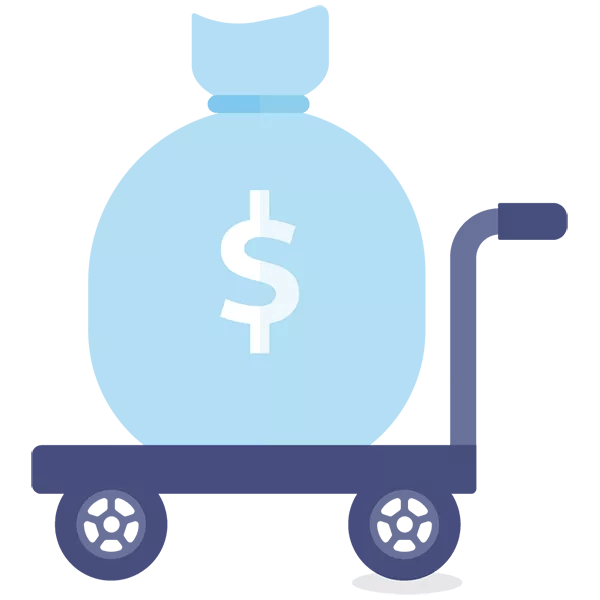Need help? We’re just a phone call away.
- A financial professional will walk you through your options.
- You’ll learn the pros and cons of each.
- When you know what you want to do, we’ll help you get started.
Call 800-247-8000, ext. 2331 to talk through your options with a financial professional.
A job change for you means new options for your retirement account.
Since you've changed jobs, your account options have changed, too. Your money is still invested, but you can't continue to contribute to your savings. We're here to help you understand your options so you can make the choice that's right for you.
You have 4 options for your account.

Keep your money where it is
Roll your money to an IRA
Move your money to a new employer's plan
Cash out your account
Leave your savings in the account with your old employer’s plan.
This could be a good fit for you if...
- You want to keep your savings invested, with the same tax advantages.
- You're happy with your current account and don’t mind leaving it with your old employer.
- You like your current investment options.
- You use the online planning tools and resources you have access to today.
But keep in mind…
- You can't add more money to the account (since it's tied to your old job) or borrow money from it.
- You’re limited to the investments your old employer chooses for the plan, and they can change the investments or other plan features (you'll be notified first).
Move your savings to an individual retirement account (IRA). Not familiar with IRAs? Here’s a refresher.
This could be a good fit for you if...
- You want to keep your savings invested, with the same tax advantages.
- You want more investment options—and you’d like a professional to help you pick a mix of investments for you.
- You want to be able to save for retirement in 1 spot that stays with you, even if you end up working somewhere without a retirement plan.
- You want the greater flexibility and control of an account you own individually.
But keep in mind…
- You can’t borrow money from an IRA (although you might be able to withdraw contributions for certain expenses).
- You generally need to be at least age 59½ to withdraw your money penalty-free, compared to age 55 for most employer plans (if you leave your employer).
Move your savings to your current employer’s plan (if one’s available).
This could be a good fit for you if...
- You want to keep your savings invested, with the same tax advantages.
- You like the convenience of saving for retirement directly out of your paycheck.
- You’d rather pick from a set list of investment options and you like the ones your employer’s plan offers.
- You might want to borrow money from your account someday.
But keep in mind…
- If you want to roll outside savings into your account, you’ll need to check with your employer first; not all plans allow it.
- Not all plans allow loans; check with your employer.
- If you change jobs in the future, you’ll have to decide what to do with your account (just like now).
You can take some or all of your savings as cash.
This could be a good fit for you if...
- You need cash now.
But keep in mind…
- You'll pay taxes on the amount you withdraw, right away.
- If you're under age 59 1/2, you may also pay a 10% penalty.
- The extra cash could bump you to a higher tax bracket.
- You might not have enough savings when you retire.
Leave your savings in the account with your old employer’s plan.
This could be a good fit for you if...
- You want to keep your savings invested, with the same tax advantages.
- You're happy with your current account and don’t mind leaving it with your old employer.
- You like your current investment options.
- You use the online planning tools and resources you have access to today.
But keep in mind…
- You can't add more money to the account (since it's tied to your old job) or borrow money from it.
- You’re limited to the investments your old employer chooses for the plan, and they can change the investments or other plan features (you'll be notified first).
Move your savings to an individual retirement account (IRA). Not familiar with IRAs? Here’s a refresher.
This could be a good fit for you if...
- You want to keep your savings invested, with the same tax advantages.
- You want more investment options—and you’d like a professional to help you pick a mix of investments for you.
- You want to be able to save for retirement in 1 spot that stays with you, even if you end up working somewhere without a retirement plan.
- You want the greater flexibility and control of an account you own individually.
But keep in mind…
- You can’t borrow money from an IRA (although you might be able to withdraw contributions for certain expenses).
- You generally need to be at least age 59½ to withdraw your money penalty-free, compared to age 55 for most employer plans (if you leave your employer).
Move your savings to your current employer’s plan (if one’s available).
This could be a good fit for you if...
- You want to keep your savings invested, with the same tax advantages.
- You like the convenience of saving for retirement directly out of your paycheck.
- You’d rather pick from a set list of investment options and you like the ones your employer’s plan offers.
- You might want to borrow money from your account someday.
But keep in mind…
- If you want to roll outside savings into your account, you’ll need to check with your employer first; not all plans allow it.
- Not all plans allow loans; check with your employer.
- If you change jobs in the future, you’ll have to decide what to do with your account (just like now).
You can take some or all of your savings as cash.
This could be a good fit for you if...
- You need cash now.
But keep in mind…
- You'll pay taxes on the amount you withdraw, right away.
- If you're under age 59 1/2, you may also pay a 10% penalty.
- The extra cash could bump you to a higher tax bracket.
- You might not have enough savings when you retire.

Our goal is to explain your options in a way that's easy to understand and relate to your situation—so you feel confident you're making the right decision.
Why work with Principal?
One of the World's Most Ethical Companies.1 A member of the FORTUNE 500®. A global company with over $600 billion in assets under management, serving 62 million customers throughout Asia, Australia, Europe, Latin America, and North America.2
1 Ethisphere Institute, February 2023. This is the 12th time Principal has been recognized by Ethisphere.
2 Data for the trailing twelve months ended December 31, 2022, unless otherwise noted.
Investing involves risk, including possible loss of principal.
|
Investment and Insurance products are:
|
This document is intended to be educational in nature and is not intended to be taken as a recommendation.
You should consider the differences in investment options and risks, fees and expenses, tax implications, services and penalty-free withdrawals for your various options. The retirement plan’s investment options may have investment expenses lower than similar options offered outside of the plan. There may be other factors to consider due to your specific needs and situation. You may wish to consult your tax advisor and legal counsel.
Our one-on-one conversation includes education or, if requested, point-in-time advice service regarding your retirement plan account. For additional assistance, consult with appropriate individuals including counsel, financial professionals or other advisors on all matters pertaining to business, legal, tax, investment or accounting obligations and requirements.
Principal Advised Services is a federally-registered investment adviser. Registration does not imply a certain level of training or skill. Principal Advised Services does not guarantee that the results of their advice, recommendations or objectives of a strategy will be achieved. Please refer to the Form ADV and Form CRS for Principal Advised Services, LLC. Insurance products and plan administrative services provided through Principal Life Insurance Company®. Securities offered through Principal Securities, Inc., member SIPC and/or independent broker/dealers. Referenced companies are members of the Principal Financial Group®, Des Moines, IA 50392.
Principal®, Principal Financial Group®, and Principal and the logomark design are registered trademarks of Principal Financial Services, Inc., a Principal Financial Group company, in the United States and are trademarks and service marks of Principal Financial Services, Inc., in various countries around the world.